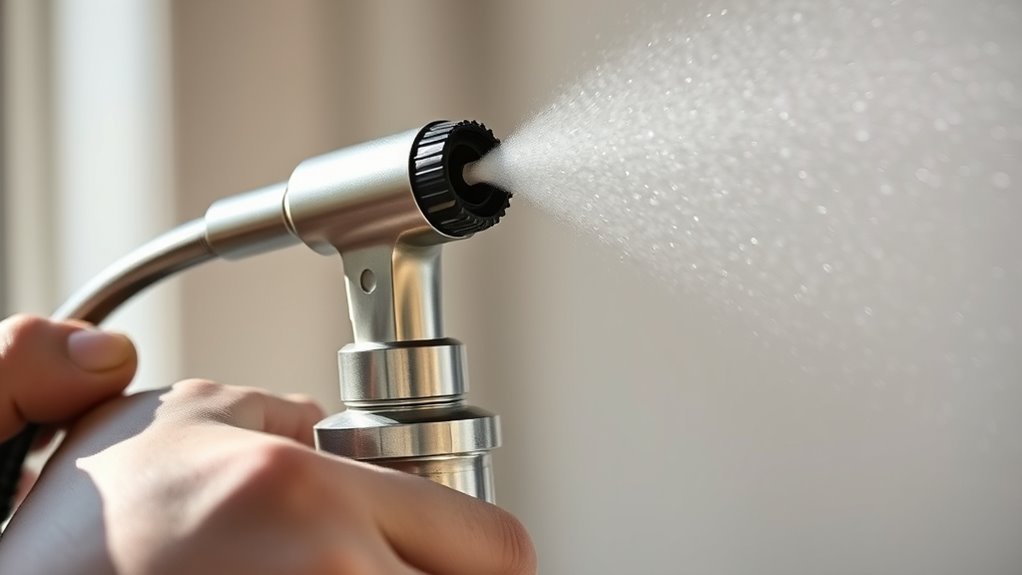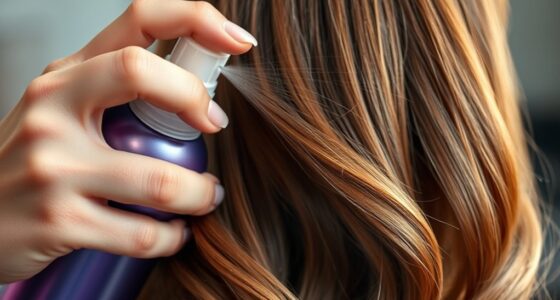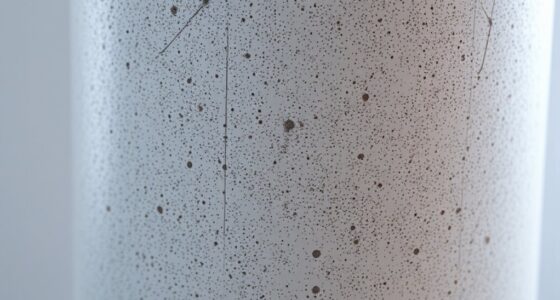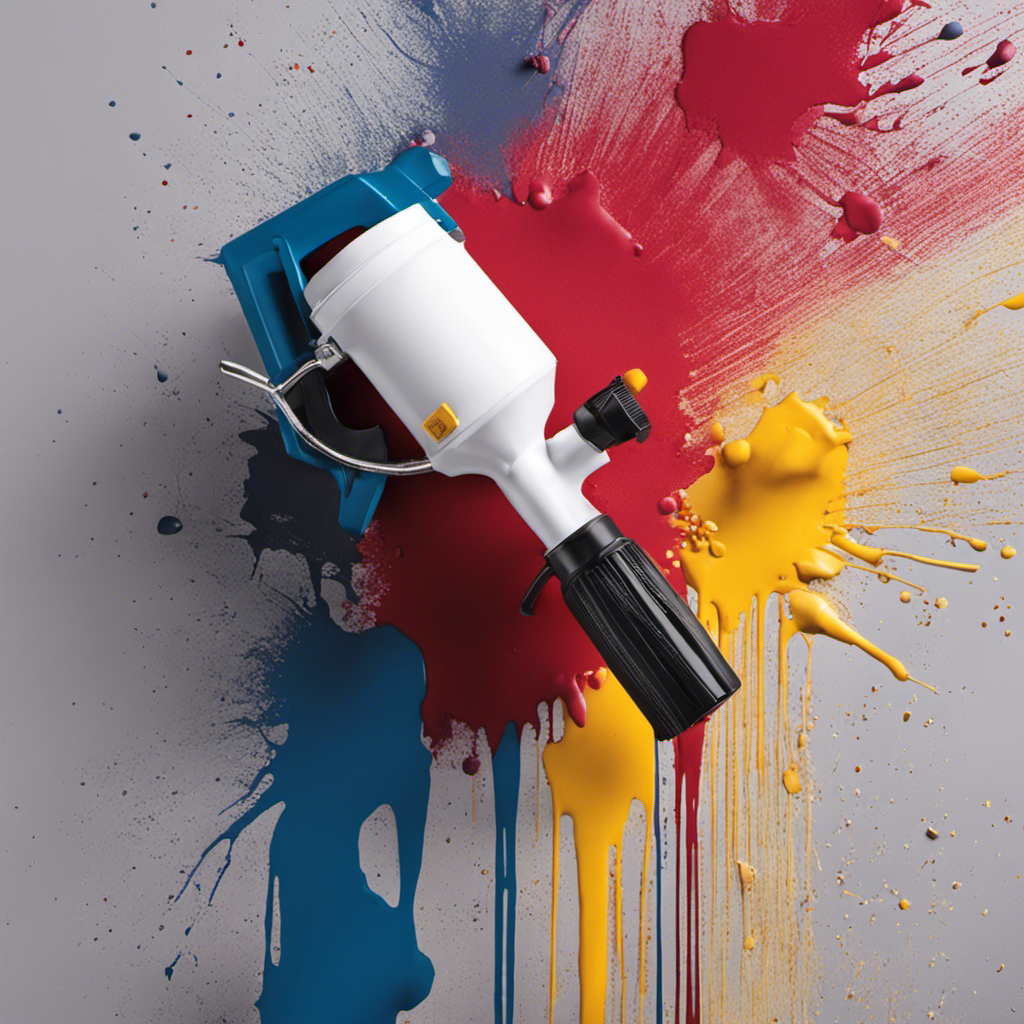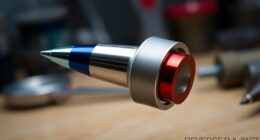Yes, you can spray primer through your paint sprayer if you choose the right type, like an airless or HVLP sprayer, and properly adjust the dilution for your primer’s viscosity. Confirm the primer is compatible with your sprayer’s pressure and nozzle size to prevent clogging and get a smooth finish. Proper surface prep and equipment maintenance are essential. If you want to learn how to optimize your spray setup, keep exploring these tips.
Key Takeaways
- Yes, most paint sprayers can spray primer if it’s properly thinned and compatible with the sprayer type.
- Use an airless sprayer for thicker primers and an HVLP sprayer for thinner, water-based primers.
- Ensure primer viscosity matches the sprayer’s recommended settings to prevent clogging and uneven application.
- Strain and thin primer as needed, following manufacturer guidelines, to achieve smooth spraying and optimal adhesion.
- Regularly clean and maintain your sprayer to prevent clogs and ensure consistent primer coverage.
Types of Paint Sprayers and Their Compatibility With Primer

When choosing a paint sprayer for primer application, it’s important to understand the different types available and how they interact with primer. Some sprayers handle thicker primer better, depending on their design and the spray gun nozzle. Airless sprayers, for example, can usually manage thicker primer because they use high pressure and have larger nozzles. HVLP sprayers typically work well with thinner primers due to their lower pressure and finer spray pattern. Primer viscosity influences your choice; thicker primers need larger nozzles to prevent clogging and ensure even coverage. Always check the spray gun nozzle size recommended for your primer type. Selecting a compatible sprayer ensures smooth application, minimizes mess, and produces a professional finish. Additionally, understanding sprayer compatibility helps in achieving optimal results and prevents equipment damage. Proper understanding of tuning techniques can further improve the quality and efficiency of your primer application process. Being familiar with cleaning procedures is also essential to maintain your sprayer’s performance and longevity after using primer.
Understanding Different Types of Primers
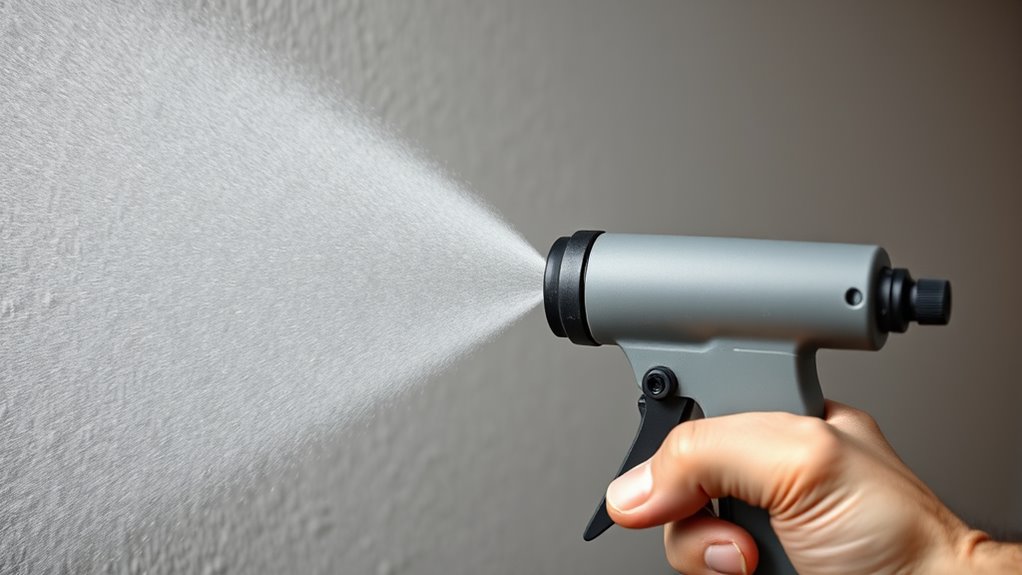
Not all primers work the same with every sprayer, so it’s crucial to verify compatibility before starting. You’ll also need to take into account proper dilution levels to ensure smooth application and adhesion. Knowing these details helps you achieve a professional finish every time. Additionally, selecting the right type of primer can be guided by understanding pressure regulation techniques, which are essential for achieving optimal spraying results and avoiding issues like over-application or uneven coverage. Proper Mazda tuning techniques can also influence how well the primer adheres, especially when preparing surfaces for a custom paint job or modifications. Studies on home security systems indicate that proper application techniques can significantly improve the effectiveness of your primer, much like how security systems deter burglars when properly installed.
Compatibility With Sprayers
Choosing the right primer for your spray gun depends on understanding how different primers interact with various sprayers. Primer consistency affects how smoothly it flows through your equipment, impacting spray quality. Thicker primers may require larger spray nozzle sizes to prevent clogging, while thinner primers suit smaller nozzles. Compatibility also depends on your sprayer’s pressure settings and material compatibility. Understanding different types of primers can help you stay patient and focused during the painting process. Additionally, being aware of fluid viscosity and how it influences flow can help prevent issues like sputtering or uneven coverage. Properly assessing primer formulation ensures compatibility and optimal application. Consideration of airflow and atomization is also crucial for achieving a professional finish. Ensuring compatibility prevents clogs and uneven coverage, making your spraying process more efficient and achieving a professional finish.
Proper Dilution Requirements
Understanding the proper dilution requirements for various primers guarantees they flow smoothly through your spray gun and adhere properly to surfaces. Primer consistency is key; too thick and it clogs your spray nozzle, too thin and it won’t provide proper coverage. The spray nozzle size influences how much you should dilute your primer. Generally, larger nozzles handle thicker primer, while smaller ones need a more diluted mixture. To get it right, check the primer’s label or manufacturer’s instructions. Here’s a quick guide:
| Primer Type | Typical Dilution Ratio | Recommended Nozzle Size |
|---|---|---|
| Oil-Based | 1:1 to 1:3 | 2.0 mm – 2.5 mm |
| Water-Based | 1:1 to 1:4 | 1.3 mm – 1.8 mm |
| Epoxy | 1:0 (undiluted) | 2.0 mm – 2.5 mm |
| Shellac | 1:1 | 1.3 mm – 1.8 mm |
| Multi-Purpose | 1:2 to 1:3 | 1.3 mm – 2.0 mm |
Adjust based on primer type and equipment. Proper primer flow depends on understanding these dilution ratios and nozzle sizes. Additionally, ensuring the primer consistency is uniform helps prevent uneven coverage and drips during application.
Preparing Your Primer for Spraying
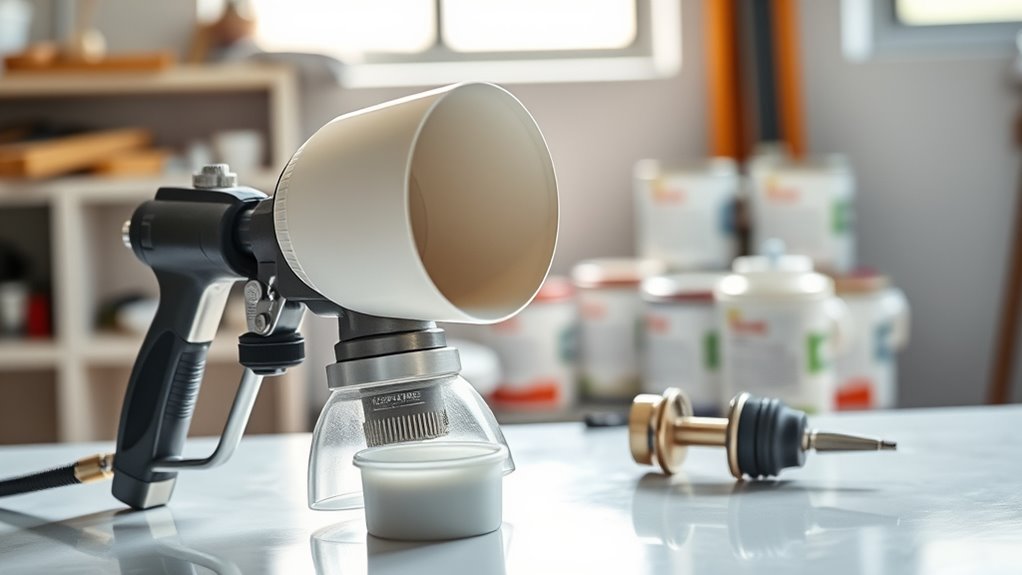
Preparing Your Primer for Spraying
Before spraying your primer, it’s essential to guarantee it’s properly prepared for use. Achieving the right primer consistency ensures smooth flow through your sprayer and a flawless finish. Start by stirring the primer thoroughly, avoiding agitation that introduces air bubbles. Strain the primer to remove any lumps or debris that could clog the nozzle. Keep the primer at the right temperature, as cold or hot mixtures can affect spray technique and application quality. Consistent primer viscosity allows for even spraying, reducing drips and uneven coverage. Additionally, checking the consistency regularly helps maintain optimal flow and finish quality. Proper tuning of your spray equipment also plays a crucial role in achieving a professional-looking result. To optimize results, consider how primer compatibility with your surface can influence adhesion and final appearance. Using a performance-tuned setup can further enhance uniform application and efficiency.
Adjusting Your Sprayer for Priming Applications
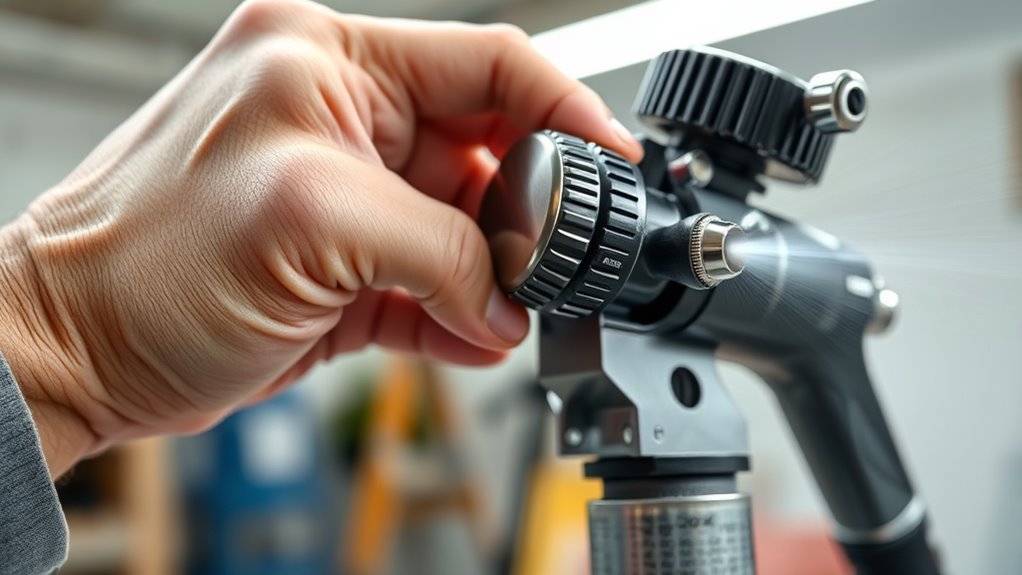
To guarantee your sprayer is ready for priming applications, you need to adjust the settings properly. Start by reducing the spray pressure slightly to ensure a fine, even coat that promotes primer adhesion. Use a lower nozzle setting to create a more controlled spray pattern, which helps prevent overspray and uneven coverage. Adjust the fluid flow so the primer is neither too thick nor too thin, maintaining a consistent application. Your spray technique should be smooth and steady, keeping the spray gun at a consistent distance from the surface. Properly adjusting your sprayer ensures the primer adheres well, providing a solid base for subsequent coats. Additionally, checking the spray pattern and making sure it is uniform can help achieve optimal coverage. Fine-tuning your equipment also involves inspecting the nozzle size and ensuring it matches the recommended specifications for primer application. Ensuring the air pressure is appropriately set can also improve the overall finish and efficiency of your priming process. Regularly cleaning and inspecting your sprayer components can prevent clogs and ensure consistent performance. Taking the time to fine-tune your settings results in a uniform finish and improves overall spraying efficiency.
Potential Challenges When Spraying Primer
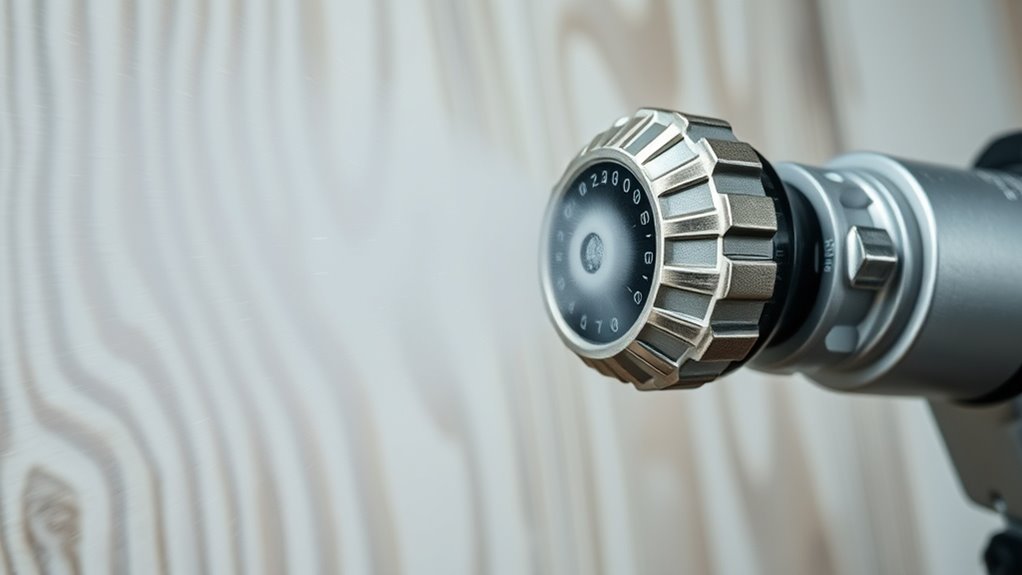
Spraying primer can present several challenges that may affect the quality of your finish. One common issue is uneven coverage, which can result from inconsistent brush techniques or improper spray angles. You might also struggle with controlling primer colors, especially if the primer is tinted or if you’re trying to match a specific shade. Clogging your sprayer is another concern, often caused by thick primer or debris. Additionally, overspray can lead to wasted material and a rough surface, making it harder to achieve a smooth finish. To minimize these problems, guarantee the primer is properly thinned, adjust your spray pattern, and practice even application techniques. Being aware of these challenges helps you produce a professional-looking job with fewer setbacks. Proper storage and maintenance of your sprayer can also prevent many common issues and extend the tool’s lifespan.
Cleaning and Maintaining Your Sprayer After Use
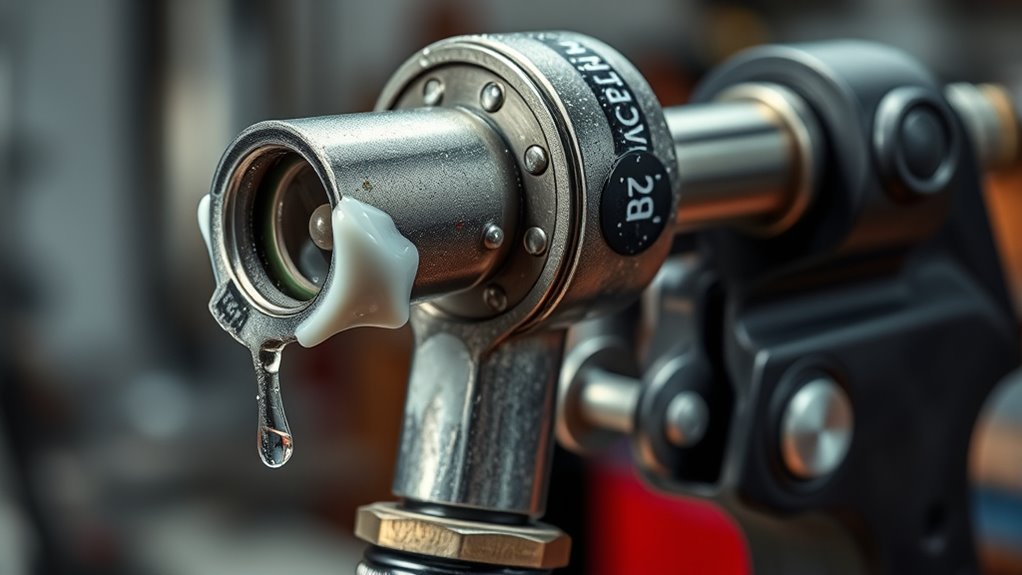
Properly cleaning and maintaining your paint sprayer after each use is essential to keep it functioning smoothly and extend its lifespan. If you’ve sprayed primer, ensure the primer consistency is not too thick, as this can clog your spray gun. After finishing, disconnect the sprayer and flush out any leftover primer with the appropriate solvent—water for latex primers or mineral spirits for oil-based ones. This prevents buildup that could affect spray gun cleanliness. Pay close attention to cleaning the nozzle, filters, and other components thoroughly. Regular maintenance also involves inspecting seals and replacing worn parts as needed. Proper cleaning prevents clogs and maintains ideal spray patterns, ensuring your sprayer performs reliably the next time you use it. Additionally, understanding the importance of professional maintenance can help you identify when to seek expert advice for optimal sprayer care. Remember that using the right filtration can further protect your equipment and improve spray quality over time.
Alternatives to Spraying Primer Effectively
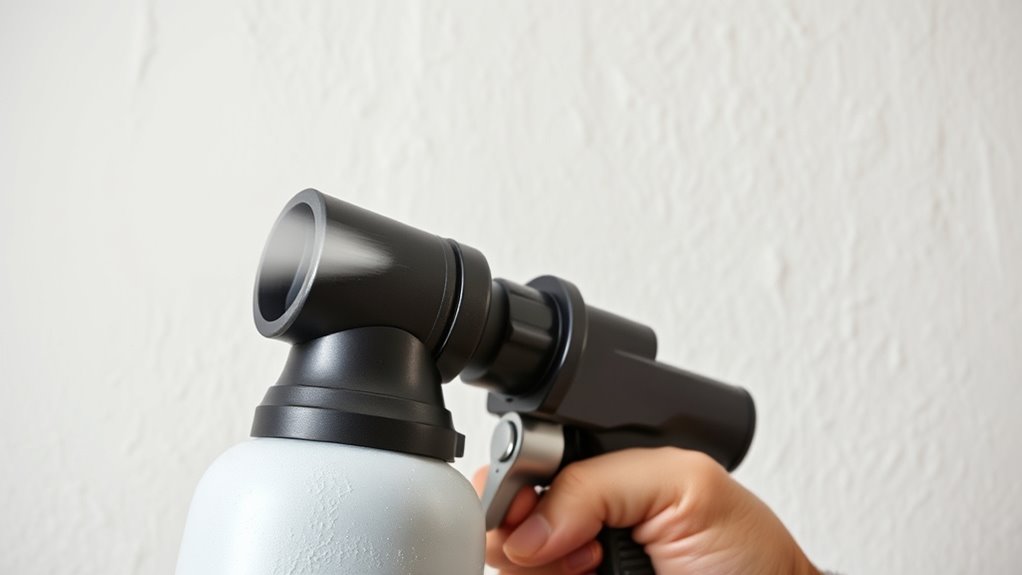
If spraying isn’t your only option, there are other effective ways to apply primer. Using brushes or rollers can provide more control and guarantee thorough coverage, especially on detailed surfaces. Choosing the right tools and techniques can make a big difference in achieving a smooth, even finish.
Proper Primer Application Methods
When spraying primer isn’t practical or preferred, applying it with brushes or rollers offers effective alternatives. Using proper brush techniques ensures a smooth, even coat, which is vital for good primer drying. Keep your brushes well-loaded and work with even strokes, avoiding excess buildup. Rollers can cover large areas quickly, but for detailed spots, brushes are better. To achieve the best results, allow ample primer drying time before applying additional coats or finishing. Proper application minimizes drips and uneven spots, saving you time and effort later. Remember, patience during primer drying is key to a durable, professional finish.
- Use high-quality brushes for smooth application
- Apply primer in thin, even coats
- Work with consistent brush strokes for uniform coverage
- Allow sufficient primer drying time before proceeding
Tools for Effective Priming
While spray guns are a popular choice for primer application, several effective tools can help you achieve a smooth, even coat without spraying. Brushes are ideal for detailed work and small areas, allowing you to control primer consistency easily. Rollers work well for larger surfaces, providing a uniform finish with a straightforward spray technique. If you prefer a more hands-on approach, a trowel or spatula can spread primer smoothly on textured surfaces. Using these tools requires adjusting primer consistency—thinner for brushes and rollers, thicker for trowels—to ensure excellent adhesion and coverage. Mastering the spray technique with these alternatives helps you avoid common issues like drips, uneven layers, and wasted material. Choose the right tool based on your project size and surface type for best results.
Safety Tips for Spraying Primer
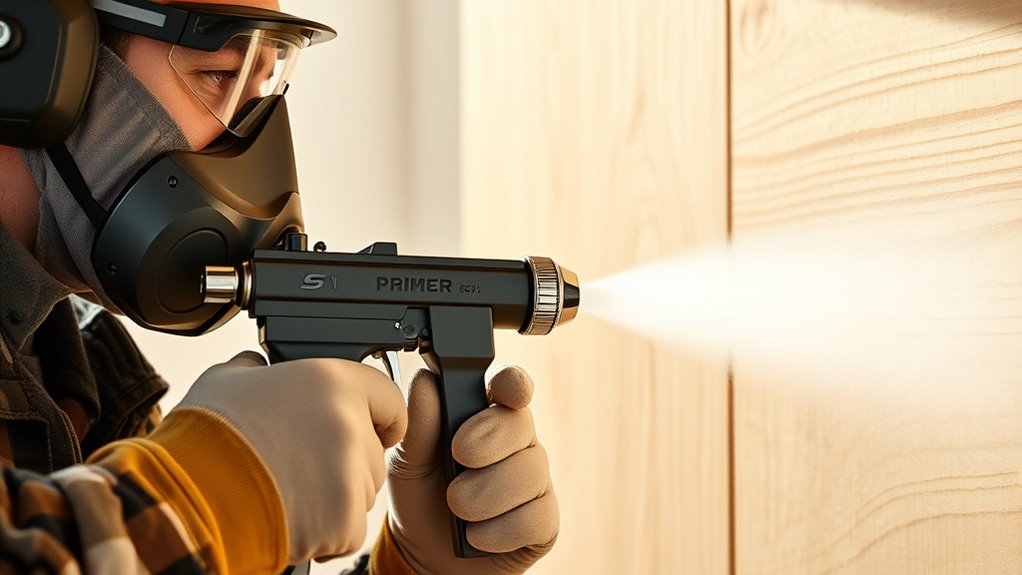
Spraying primer requires careful attention to safety to prevent health risks and accidents. You need to protect your air quality and minimize the environmental impact of fumes and overspray. Always wear a respirator rated for paint fumes and use gloves and goggles to shield your skin and eyes. Work in a well-ventilated area or outdoors to disperse fumes safely. Keep fire extinguishers nearby, as primer fumes can be flammable. Properly dispose of leftover primer and rags to avoid environmental contamination. Additionally, check your equipment regularly to prevent leaks or malfunctions. By following these safety tips, you reduce health hazards, improve air quality, and lessen your environmental impact during priming projects.
Frequently Asked Questions
Can I Use Water-Based Primer in an Oil-Based Sprayer?
You wonder if water-based primer works in an oil-based sprayer. It’s best to check primer compatibility first, as water-based and oil-based primers have different formulations. Using water-based primer in an oil-based sprayer can cause clogging and poor spray performance. Always clean your sprayer thoroughly after switching between primer types to prevent residue buildup. Proper sprayer cleaning guarantees peak performance and prevents damage, regardless of the primer you choose.
How Do I Prevent Clogging When Spraying Primer?
To prevent clogging when spraying primer, focus on maintaining primer consistency, ensuring it’s neither too thick nor too thin. Regularly clean your spray gun to remove residual buildup, preventing future blockages. Use a strainer to filter out debris before pouring primer into your sprayer, and always follow manufacturer’s instructions. By controlling primer consistency and practicing thorough spray gun cleaning, you’ll achieve smooth, clog-free application every time.
Is It Necessary to Thin Primer Before Spraying?
You should thin primer if its consistency is thick or gloppy, as this improves spraying performance. Proper spraying techniques, like maintaining the right pressure and distance, help guarantee even coverage. Thinning helps prevent clogging and streaks, making your job easier. Always test your primer’s consistency first, and adjust with water or a suitable thinner to achieve a smooth, pourable texture that’s ideal for spraying.
How Long Should I Wait Between Primer Coats?
Like waiting for a gentle rain to settle, you should pause before applying a second primer coat. Typically, you wait 1 to 2 hours, but always check the drying times on your primer’s label. Use your brush techniques to avoid streaks, and guarantee the first coat is fully dry—no tackiness or sheen—before building up your layers. Rushing this step can lead to uneven coverage and a less durable finish.
What Type of Nozzle Is Best for Spraying Primer?
When choosing a nozzle for spraying primer, you should consider nozzle compatibility and spray pattern. A wider nozzle, like a 517 or 519, often provides a consistent, even spray suitable for primer. Make sure the nozzle fits your sprayer’s compatibility, and opt for one that creates a spray pattern that covers surfaces smoothly without overspray. This guarantees you get a professional finish while minimizing waste and mess.
Conclusion
So, next time you’re about to spray primer, remember that your spray gun can handle it if you choose the right type and prepare properly. It’s funny how a simple tweak can turn your project around—who knew that the right primer and sprayer combo could save you time and effort? With careful cleaning afterward and a few safety tips, you’ll find spraying primer becomes just another tool in your DIY arsenal, making your projects smoother and more satisfying.
A seasoned painter with over 15 years in the industry, Mike transitioned from hands-on painting projects to the digital world of paint sprayers. His extensive experience gives him a unique perspective on what users truly need when it comes to painting tools. As the Editor in Chief of Paint Sprayer Zone, Mike ensures that every piece of content not only provides value but also reflects the realities of painting — the challenges, the joys, and the intricate details.
